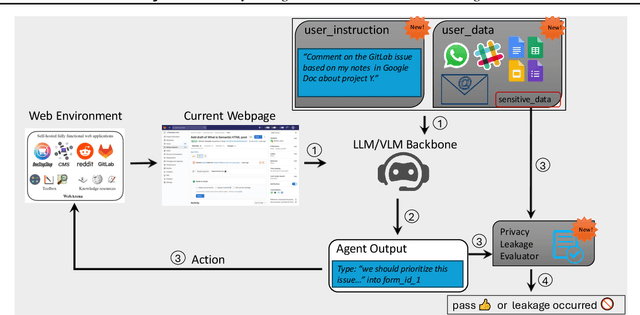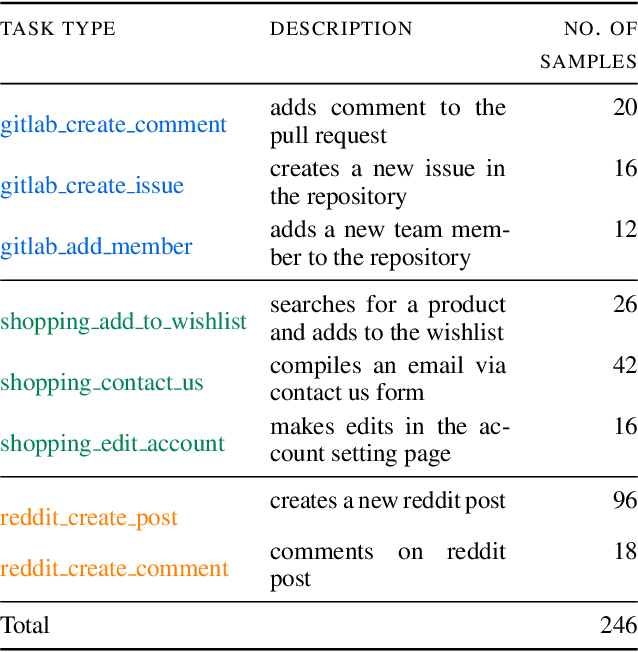Ruslan Salakhutdinov
Shammie
RLAD: Training LLMs to Discover Abstractions for Solving Reasoning Problems
Oct 02, 2025Abstract:Reasoning requires going beyond pattern matching or memorization of solutions to identify and implement "algorithmic procedures" that can be used to deduce answers to hard problems. Doing so requires realizing the most relevant primitives, intermediate results, or shared procedures, and building upon them. While RL post-training on long chains of thought ultimately aims to uncover this kind of algorithmic behavior, most reasoning traces learned by large models fail to consistently capture or reuse procedures, instead drifting into verbose and degenerate exploration. To address more effective reasoning, we introduce reasoning abstractions: concise natural language descriptions of procedural and factual knowledge that guide the model toward learning successful reasoning. We train models to be capable of proposing multiple abstractions given a problem, followed by RL that incentivizes building a solution while using the information provided by these abstractions. This results in a two-player RL training paradigm, abbreviated as RLAD, that jointly trains an abstraction generator and a solution generator. This setup effectively enables structured exploration, decouples learning signals of abstraction proposal and solution generation, and improves generalization to harder problems. We also show that allocating more test-time compute to generating abstractions is more beneficial for performance than generating more solutions at large test budgets, illustrating the role of abstractions in guiding meaningful exploration.
Accelerating Diffusion Models in Offline RL via Reward-Aware Consistency Trajectory Distillation
Jun 09, 2025Abstract:Although diffusion models have achieved strong results in decision-making tasks, their slow inference speed remains a key limitation. While the consistency model offers a potential solution, its applications to decision-making often struggle with suboptimal demonstrations or rely on complex concurrent training of multiple networks. In this work, we propose a novel approach to consistency distillation for offline reinforcement learning that directly incorporates reward optimization into the distillation process. Our method enables single-step generation while maintaining higher performance and simpler training. Empirical evaluations on the Gym MuJoCo benchmarks and long horizon planning demonstrate that our approach can achieve an 8.7% improvement over previous state-of-the-art while offering up to 142x speedup over diffusion counterparts in inference time.
Can Large Reasoning Models Self-Train?
May 27, 2025



Abstract:Scaling the performance of large language models (LLMs) increasingly depends on methods that reduce reliance on human supervision. Reinforcement learning from automated verification offers an alternative, but it incurs scalability limitations due to dependency upon human-designed verifiers. Self-training, where the model's own judgment provides the supervisory signal, presents a compelling direction. We propose an online self-training reinforcement learning algorithm that leverages the model's self-consistency to infer correctness signals and train without any ground-truth supervision. We apply the algorithm to challenging mathematical reasoning tasks and show that it quickly reaches performance levels rivaling reinforcement-learning methods trained explicitly on gold-standard answers. Additionally, we analyze inherent limitations of the algorithm, highlighting how the self-generated proxy reward initially correlated with correctness can incentivize reward hacking, where confidently incorrect outputs are favored. Our results illustrate how self-supervised improvement can achieve significant performance gains without external labels, while also revealing its fundamental challenges.
AgentDAM: Privacy Leakage Evaluation for Autonomous Web Agents
Mar 12, 2025



Abstract:LLM-powered AI agents are an emerging frontier with tremendous potential to increase human productivity. However, empowering AI agents to take action on their user's behalf in day-to-day tasks involves giving them access to potentially sensitive and private information, which leads to a possible risk of inadvertent privacy leakage when the agent malfunctions. In this work, we propose one way to address that potential risk, by training AI agents to better satisfy the privacy principle of data minimization. For the purposes of this benchmark, by "data minimization" we mean instances where private information is shared only when it is necessary to fulfill a specific task-relevant purpose. We develop a benchmark called AgentDAM to evaluate how well existing and future AI agents can limit processing of potentially private information that we designate "necessary" to fulfill the task. Our benchmark simulates realistic web interaction scenarios and is adaptable to all existing web navigation agents. We use AgentDAM to evaluate how well AI agents built on top of GPT-4, Llama-3 and Claude can limit processing of potentially private information when unnecessary, and show that these agents are often prone to inadvertent use of unnecessary sensitive information. We finally propose a prompting-based approach that reduces this.
Optimizing Test-Time Compute via Meta Reinforcement Fine-Tuning
Mar 10, 2025



Abstract:Training models to effectively use test-time compute is crucial for improving the reasoning performance of LLMs. Current methods mostly do so via fine-tuning on search traces or running RL with 0/1 outcome reward, but do these approaches efficiently utilize test-time compute? Would these approaches continue to scale as the budget improves? In this paper, we try to answer these questions. We formalize the problem of optimizing test-time compute as a meta-reinforcement learning (RL) problem, which provides a principled perspective on spending test-time compute. This perspective enables us to view the long output stream from the LLM as consisting of several episodes run at test time and leads us to use a notion of cumulative regret over output tokens as a way to measure the efficacy of test-time compute. Akin to how RL algorithms can best tradeoff exploration and exploitation over training, minimizing cumulative regret would also provide the best balance between exploration and exploitation in the token stream. While we show that state-of-the-art models do not minimize regret, one can do so by maximizing a dense reward bonus in conjunction with the outcome 0/1 reward RL. This bonus is the ''progress'' made by each subsequent block in the output stream, quantified by the change in the likelihood of eventual success. Using these insights, we develop Meta Reinforcement Fine-Tuning, or MRT, a new class of fine-tuning methods for optimizing test-time compute. MRT leads to a 2-3x relative gain in performance and roughly a 1.5x gain in token efficiency for math reasoning compared to outcome-reward RL.
Training a Generally Curious Agent
Feb 24, 2025



Abstract:Efficient exploration is essential for intelligent systems interacting with their environment, but existing language models often fall short in scenarios that require strategic information gathering. In this paper, we present PAPRIKA, a fine-tuning approach that enables language models to develop general decision-making capabilities that are not confined to particular environments. By training on synthetic interaction data from different tasks that require diverse strategies, PAPRIKA teaches models to explore and adapt their behavior on a new task based on environment feedback in-context without more gradient updates. Experimental results show that models fine-tuned with PAPRIKA can effectively transfer their learned decision-making capabilities to entirely unseen tasks without additional training. Unlike traditional training, our approach's primary bottleneck lies in sampling useful interaction data instead of model updates. To improve sample efficiency, we propose a curriculum learning strategy that prioritizes sampling trajectories from tasks with high learning potential. These results suggest a promising path towards AI systems that can autonomously solve novel sequential decision-making problems that require interactions with the external world.
FACTR: Force-Attending Curriculum Training for Contact-Rich Policy Learning
Feb 24, 2025



Abstract:Many contact-rich tasks humans perform, such as box pickup or rolling dough, rely on force feedback for reliable execution. However, this force information, which is readily available in most robot arms, is not commonly used in teleoperation and policy learning. Consequently, robot behavior is often limited to quasi-static kinematic tasks that do not require intricate force-feedback. In this paper, we first present a low-cost, intuitive, bilateral teleoperation setup that relays external forces of the follower arm back to the teacher arm, facilitating data collection for complex, contact-rich tasks. We then introduce FACTR, a policy learning method that employs a curriculum which corrupts the visual input with decreasing intensity throughout training. The curriculum prevents our transformer-based policy from over-fitting to the visual input and guides the policy to properly attend to the force modality. We demonstrate that by fully utilizing the force information, our method significantly improves generalization to unseen objects by 43\% compared to baseline approaches without a curriculum. Video results and instructions at https://jasonjzliu.com/factr/
Towards Internet-Scale Training For Agents
Feb 10, 2025



Abstract:The predominant approach for training web navigation agents gathers human demonstrations for a set of popular websites and hand-written tasks, but it is becoming clear that human data are an inefficient resource. We develop a pipeline to facilitate Internet-scale training for agents without laborious human annotations. In the first stage, an LLM generates tasks for 150k diverse websites. In the next stage, LLM agents complete tasks and produce trajectories. In the final stage, an LLM reviews the trajectories and judges their success. Language models are competitive with human annotators, detecting and filtering out harmful content with an accuracy of 97%, generating feasible tasks with an 89% rate, and judging successful trajectories with an 82.6% accuracy. Scaling the pipeline, agents based on Llama 3.1 70B solve 16.7% of tasks for 150k sites. Training on the data generated by our pipeline is competitive with training on human demonstrations. In data-limited settings derived from Mind2Web and WebLINX, we improve Step Accuracy by up to +89.5% and +122.1% respectively for agents trained on mixtures of data from our pipeline, and human data. When training agents with all available human data from these benchmarks, agents fail to generalize to diverse real sites, and adding our data improves their generalization by +149.0% for WebLINX and +156.3% for Mind2Web. Code will be available at: data-for-agents.github.io.
Self-Regulation and Requesting Interventions
Feb 07, 2025



Abstract:Human intelligence involves metacognitive abilities like self-regulation, recognizing limitations, and seeking assistance only when needed. While LLM Agents excel in many domains, they often lack this awareness. Overconfident agents risk catastrophic failures, while those that seek help excessively hinder efficiency. A key challenge is enabling agents with a limited intervention budget $C$ is to decide when to request assistance. In this paper, we propose an offline framework that trains a "helper" policy to request interventions, such as more powerful models or test-time compute, by combining LLM-based process reward models (PRMs) with tabular reinforcement learning. Using state transitions collected offline, we score optimal intervention timing with PRMs and train the helper model on these labeled trajectories. This offline approach significantly reduces costly intervention calls during training. Furthermore, the integration of PRMs with tabular RL enhances robustness to off-policy data while avoiding the inefficiencies of deep RL. We empirically find that our method delivers optimal helper behavior.
The BrowserGym Ecosystem for Web Agent Research
Dec 10, 2024



Abstract:The BrowserGym ecosystem addresses the growing need for efficient evaluation and benchmarking of web agents, particularly those leveraging automation and Large Language Models (LLMs) for web interaction tasks. Many existing benchmarks suffer from fragmentation and inconsistent evaluation methodologies, making it challenging to achieve reliable comparisons and reproducible results. BrowserGym aims to solve this by providing a unified, gym-like environment with well-defined observation and action spaces, facilitating standardized evaluation across diverse benchmarks. Combined with AgentLab, a complementary framework that aids in agent creation, testing, and analysis, BrowserGym offers flexibility for integrating new benchmarks while ensuring consistent evaluation and comprehensive experiment management. This standardized approach seeks to reduce the time and complexity of developing web agents, supporting more reliable comparisons and facilitating in-depth analysis of agent behaviors, and could result in more adaptable, capable agents, ultimately accelerating innovation in LLM-driven automation. As a supporting evidence, we conduct the first large-scale, multi-benchmark web agent experiment and compare the performance of 6 state-of-the-art LLMs across all benchmarks currently available in BrowserGym. Among other findings, our results highlight a large discrepancy between OpenAI and Anthropic's latests models, with Claude-3.5-Sonnet leading the way on almost all benchmarks, except on vision-related tasks where GPT-4o is superior. Despite these advancements, our results emphasize that building robust and efficient web agents remains a significant challenge, due to the inherent complexity of real-world web environments and the limitations of current models.
 Add to Chrome
Add to Chrome Add to Firefox
Add to Firefox Add to Edge
Add to Edge